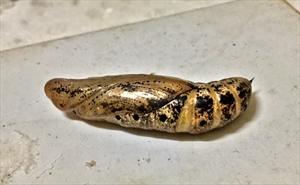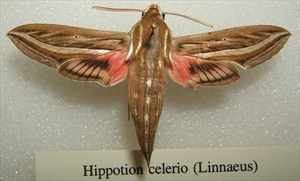Taro hornworm
Pacific Pests, Pathogens, Weeds & Pesticides - Online edition
Pacific Pests, Pathogens, Weeds & Pesticides
Taro hornworm (032)
Hippotion celerio. It is a member of the Sphingidae.
Asia, Africa, Europe, Oceania. It is recorded from Australia, Fiji, Guam, Kiribati, Nauru, New Caledonia, New Zealand, Papua New Guinea, Samoa, Solomon Islands, Tonga, and Vanuatu.
Taro, sweetpotato, and noni (Morinda sp.)
The caterpillars do the damage. They eat the leaves, leaving only the main veins (Photo 1). Sometimes even these are eaten and only the petioles are left (Photo 2).
The eggs, round, 1-1.5 mm diameter, are laid singly on both sides of the leaf and on the petioles (Photo 3). They vary from round to oval, and from clear to bluish-green. Just before the emergence of the caterpillars they are green-yellow. The caterpillars moult four times: at first they are pale yellow, then, as they age, they become green and dark brown (Photo 4). Some remain green. The eyespots and a yellow line running almost the entire length of the caterpillar develop after the first moult. When mature, the caterpillars are 80-90 mm long. At this stage, they move to the soil, form a cocoon or cell in the leaf litter or just below the soil, and pupate (Photo 5). The pupae are grey-brown, 45-50 mm long, with dark brown specks. This period lasts 15-18 days.
Adults have wingspans of 40-90 mm; they are streamlined, with large heads and eyes (Photo 6). The forewings are long, narrow and much larger than the hind wings. The forewings have an oblique silver stripe across a generally grey background, while the hind wings may have pink or brown and black areas. At rest, the wings are 'tented' over the body. The moths are capable of flying long distances and are attracted to light.
Outbreaks are uncommon as the caterpillars are under control from natural enemies; otherwise, the caterpillars can be very damaging.
The damage done to taro is characteristic of this hornworm. Look for the way that the leaves are eaten between the veins. Also, the caterpillars can be found on the leaves during the day, especially on the underside. Look for a large caterpillar with eyespots at the front end, with a line along the sides, and a horn at the end.
NATURAL ENEMIES
These include egg parasites - Trichogramma sp. (a wasp); and larval parasites Palexorista sp. (a fly), Snellenius hippotionus (a wasp), and there are probably many more. The cane toad may also feed on the larvae.
CULTURAL CONTROL
It is important that growers visit the gardens frequently and regularly, twice a week is recommended, to check if there are egg masses and young caterpillars on the leaves. Mostly, taro hornworm is under control by natural enemies, and it is only very occasionally that outbreaks occur.
The caterpillars are large, and handpicking is an option if the numbers and areas of infestation are small. If they are large, chickens are often a good way of managing outbreaks.
CHEMICAL CONTROL
Pesticides are not normally recommended for the control of this moth on taro. They are only needed when the natural enemies have been destroyed by cyclones, droughts, or when plantings are in isolated places. In these situations, do the following:
- Use plant-derived products (see Fact Sheet no. 56), such as neem, derris, pyrethrum and chilli (with the addition of soap), or commercial products that contain disease-causing organisms, such as spinosad (Success) and Bt - Bacillus thuringiensis subspecies kurstaki.
- Synthetic pyrethroids are likely to be effective, but will also kill natural enemies.
--------------------
Note,
derris (Derris species) contains rotenone, an insecticide, often used as a fish poison; it should be used with caution. The commercial derris insecticide is made from Derris elliptica.
____________________
When using a pesticide (or biopesticides), always wear protective clothing and follow the instructions on the product label, such as dosage, timing of application, and pre-harvest interval. Recommendations will vary with the crop and system of cultivation. Expert advice on the most appropriate pesticide to use should always be sought from local agricultural authorities.
AUTHORS Helen Tsatsia & Grahame Jackson
Information from Diongzon, Jr, Gapasin DP (1981) Biology of taro hornworm, Hippotion celerio L. Annals of Tropical Research. (https://annalsoftropicalresearch.com/biology-of-taro-hornworm-hippotion-celerio-l/); and from Carmichael A, et al. (2008) TaroPest: an illustrated guide to pests and diseases of taro in the South Pacific. ACIAR Monograph No. 132, 76 pp. (https://lrd.spc.int/about-lrd/lrd-project-partners/taropest). Photo 3 Mike Furlong, University of Queensland, Brisbane. Photo 5 Wikipedia. (http://en.wikipedia.org/wiki/Hippotion_celerio). Photo 5 Mani Mua, SPC, Sigatoka Research Station, Fiji.
Produced with support from the Australian Centre for International Agricultural Research under project PC/2010/090: Strengthening integrated crop management research in the Pacific Islands in support of sustainable intensification of high-value crop production, implemented by the University of Queensland and the Secretariat of the Pacific Community.









